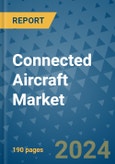The global connected aircraft market is on a trajectory of significant expansion, with a projected valuation of US$20.6 billion by 2030, up from US$9.8 billion in 2022. Analysts anticipate a remarkable Compound Annual Growth Rate (CAGR) of 11.2% during the period of 2023 to 2030, driven by key trends and determinants shaping the industry.
This product will be delivered within 1-3 business days.
Key Market Trends Fueling Growth
- Demand for Real-time Data Analytics and Passenger Experience Enhancement: The increasing demand for real-time data analytics and enhanced passenger experience emerges as a key trend driving the connected aircraft market growth. Airlines are investing in advanced technologies to cater to passenger expectations and improve operational efficiency.
- Advancements in Satellite Communication Technology: Continuous advancements in satellite communication technology fuel the expansion of the connected aircraft market. These advancements enable seamless data sharing between aircraft and ground systems, enhancing connectivity and safety standards.
- Focus on Digitization and Real-time Data Sharing: The industry is witnessing expansion due to increased focus on digitization and the need for real-time data sharing between aircraft and ground systems. This trend enhances operational efficiency and safety measures, driving market growth.
Key Growth Factors
- In-Flight Connectivity Revolution: In-flight connectivity stands as a primary market driver, revolutionizing air travel by providing seamless internet access to passengers. The growing expectation of passengers for reliable internet access during flights propels airlines to invest in advanced satellite communication systems.
- Operational Efficiency and Predictive Maintenance: Airlines adopt connected technologies to optimize flight operations, streamline maintenance processes, and improve overall efficiency. Predictive maintenance, enabled by IoT sensors and real-time data analytics, reduces downtime and operational costs significantly.
- Enhanced Safety and Situational Awareness: Connected aircraft solutions significantly enhance safety and situational awareness for both pilots and ground control. Real-time data streaming enables predictive analytics, aiding in proactive risk mitigation and informed decision-making during flights.
Major Restraints
- Regulatory Challenges and Compliance Burden: Stringent regulatory requirements pose challenges for implementing advanced connectivity solutions in aircraft. Navigating complex regulations imposed by aviation authorities worldwide becomes a significant hurdle for aviation companies.
- Cybersecurity Concerns and Data Vulnerability: The sensitive nature of data transmitted and stored in connected aircraft systems raises cybersecurity concerns. Ensuring robust cybersecurity measures becomes imperative to safeguard critical flight data and operational details.
Key Trends and Opportunities
- In-Flight Entertainment Evolution: The connected aircraft market witnesses a surge in innovative in-flight entertainment systems, offering advanced streaming services and interactive content to enhance passenger experiences.
- IoT Integration and Predictive Maintenance: IoT integration leads to predictive maintenance, minimizing downtime and reducing operational costs. Predictive maintenance becomes a standard practice, ensuring optimal aircraft performance and safety.
- Enhanced Passenger Connectivity: Passenger demand for seamless connectivity drives market growth, leading to advancements in satellite technology and high-speed Wi-Fi installations by airlines.
Regional Outlook
- Asia Pacific: Responsible for 40% of global market revenue, Asia Pacific leads due to robust aviation sector growth and increasing investments in modernizing aircraft fleets.
- North America: Emerges as highly lucrative with around 35% market share, driven by ongoing advancements in aviation technologies and demand for in-flight connectivity services.
Competitive Landscape Analysis
Innovation and differentiation will be key drivers in the competitive landscape. Companies offering unique solutions and integrating AI and machine learning algorithms into connected aircraft systems are likely to gain a competitive edge.Leaders in Global Connected Aircraft Space
- Anuvu
- Cobham Plc
- Thales Group
- GOGO LLC
- Panasonic Avionics Company
- Honeywell International Inc.
- BAE Systems PLC
- Collins Aerospace
- Kontron
- ViaSat Inc.
- Inmarsat Global Limited
- Raytheon Inc
- Eagle Entertainment Inc
- Delta Air Lines
- FlyExclusive
Connected Aircraft Market is Segmented as Below:
By Type :
- Hardware
- Software
By Platform:
- Commercial
- Business & General Aviation
- Military
- UAV
- AAM
By Connectivity:
- In-Flight
- Air-To-Air
- Air-To-Ground
By Geographic Coverage:
- North America
- Europe
- Asia Pacific
- Latin America
- Middle East & Africa
This product will be delivered within 1-3 business days.
Table of Contents
1. Executive Summary
2. Market Overview
3. Global Connected Aircraft Market Outlook, 2018 - 2030
4. North America Connected Aircraft Market Outlook, 2018 - 2030
5. Europe Connected Aircraft Market Outlook, 2018 - 2030
6. Asia Pacific Connected Aircraft Market Outlook, 2018 - 2030
7. Latin America Connected Aircraft Market Outlook, 2018 - 2030
8. Middle East & Africa Connected Aircraft Market Outlook, 2018 - 2030
9. Competitive Landscape
10. Appendix
Companies Mentioned
- Anuvu
- Cobham Plc
- Thales Group
- GOGO LLC
- Panasonic Avionics Company
- Honeywell International Inc.
- BAE Systems PLC
- Collins Aerospace
- Kontron
- ViaSat Inc.
- Inmarsat Global Limited
- Raytheon Inc
- Eagle Entertainment Inc
- Delta Air Lines
- FlyExclusive
Methodology

LOADING...








